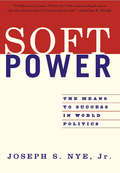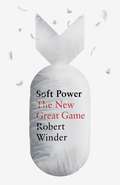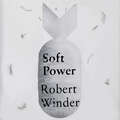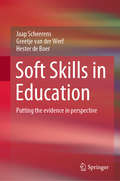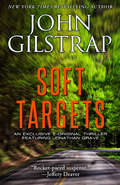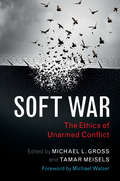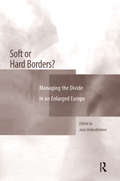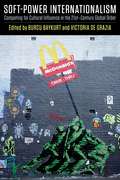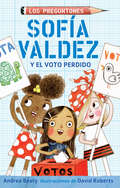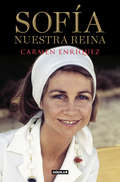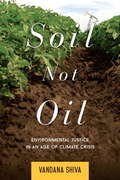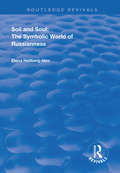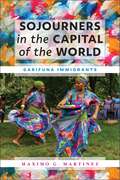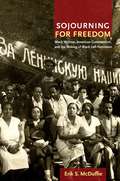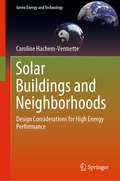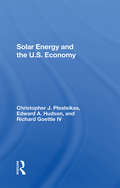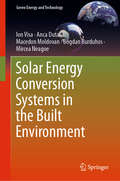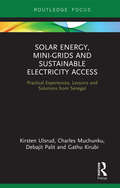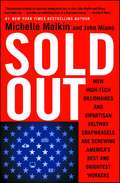- Table View
- List View
Soft Power: The Means To Success In World Politics
by Joseph S Nye JrFrom the pre-eminent scholar of foreign policy, a guide to soft power: the ability of governments to attract and persuade, rather than coerce by force Joseph S. Nye, Jr. coined the term &“soft power&” to describe a nation&’s ability to attract and persuade. Whereas hard power—the ability to coerce— grows out of a country&’s military or economic might, soft power arises from the attractiveness of its culture, political ideals, and policies. Hard power remains crucial in a world of states trying to guard their independence. But Nye argues that soft power – diplomacy, economic assistance, trustworthy information -- is essential as well in securing America&’s national interests. One of the most influential books on foreign policy every written, Soft Power offers vital guidance in an age of geopolitical turmoil.
Soft Power: The Means to Success in World Politics
by Joseph S. NyeHow to make friends, even after conquests.
Soft Power: The New Great Game
by Robert WinderIn recent years the modern world has developed a brave new concept: 'soft power'. It is the power of friendly persuasion rather than command, and it invites nations to compete (as they did in the nineteenth century) to expand their 'sphere of influence' as brands in a global marketplace. In Bloody Foreigners and The Last Wolf, Robert Winder explored the way Britain was shaped first by migration, and then by hidden geographical factors. Now, in Soft Power he reveals the ways in which modern states are asserting themselves not through traditional realpolitik but through alternative means: business, language, culture, ideas, sport, education, music, even food - the texture and values of history and daily life. Moving from West to East, the book tells the story of soft power by exploring the varied ways in which it operates - from an American sheriff in Poland to an English garden in Ravello, a French vineyard in Australia, an Asian restaurant in Spain, a Chinese Friendship Hall in Sudan; the fact that fifty-eight modern heads of state were educated in Britain; the student exchange that took a teenage Deng Xiaoping to a small town on the Loire; the way that Japan could seduce the world with chic food and smart computer games. Now there may be a new twist in this Great game. With soft power's quiet ingredients - education, science, trade, cultural values - and a new emphasis on shared mutual interest, it may be the only force supple enough to tackle the challenges the future looks likely to pose - not least the slam-the-door reflexes pulling in the other direction.
Soft Power: The New Great Game
by Robert WinderIn recent years the modern world has developed a brave new concept: 'soft power'. It is the power of friendly persuasion rather than command, and it invites nations to compete (as they did in the nineteenth century) to expand their 'sphere of influence' as brands in a global marketplace. In Bloody Foreigners and The Last Wolf, Robert Winder explored the way Britain was shaped first by migration, and then by hidden geographical factors. Now, in Soft Power he reveals the ways in which modern states are asserting themselves not through traditional realpolitik but through alternative means: business, language, culture, ideas, sport, education, music, even food - the texture and values of history and daily life. Moving from West to East, the book tells the story of soft power by exploring the varied ways in which it operates - from an American sheriff in Poland to an English garden in Ravello, a French vineyard in Australia, an Asian restaurant in Spain, a Chinese Friendship Hall in Sudan; the fact that fifty-eight modern heads of state were educated in Britain; the student exchange that took a teenage Deng Xiaoping to a small town on the Loire; the way that Japan could seduce the world with chic food and smart computer games. Now there may be a new twist in this Great game. With soft power's quiet ingredients - education, science, trade, cultural values - and a new emphasis on shared mutual interest, it may be the only force supple enough to tackle the challenges the future looks likely to pose - not least the slam-the-door reflexes pulling in the other direction.
Soft Power: The New Great Game
by Robert WinderIn recent years the modern world has developed a brave new concept: 'soft power'. It is the power of friendly persuasion rather than command, and it invites nations to compete (as they did in the nineteenth century) to expand their 'sphere of influence' as brands in a global marketplace. In Bloody Foreigners and The Last Wolf, Robert Winder explored the way Britain was shaped first by migration, and then by hidden geographical factors. Now, in Soft Power he reveals the ways in which modern states are asserting themselves not through traditional realpolitik but through alternative means: business, language, culture, ideas, sport, education, music, even food - the texture and values of history and daily life. Moving from West to East, the book tells the story of soft power by exploring the varied ways in which it operates - from an American sheriff in Poland to an English garden in Ravello, a French vineyard in Australia, an Asian restaurant in Spain, a Chinese Friendship Hall in Sudan; the fact that fifty-eight modern heads of state were educated in Britain; the student exchange that took a teenage Deng Xiaoping to a small town on the Loire; the way that Japan could seduce the world with chic food and smart computer games. Now there may be a new twist in this Great game. With soft power's quiet ingredients - education, science, trade, cultural values - and a new emphasis on shared mutual interest, it may be the only force supple enough to tackle the challenges the future looks likely to pose - not least the slam-the-door reflexes pulling in the other direction.
Soft Skills in Education: Putting the evidence in perspective
by Jaap Scheerens Greetje van der Werf Hester de BoerThis book examines the global movement of putting more emphasis on students’ social and emotional development in education. It provides some order in the unstructured multitude of desirable socio-emotional educational objectives and ambitions that have resulted from this movement and builds on a careful conceptual analysis. It starts out by examining the roots of the movement and discusses different emphases. Next it makes use of instructional and psychological constructs and theories to arrive at meaningful categorizations of major domains and types of social-emotional “skills”. One of the key assumptions is that social and emotional attributes are malleable by means of educational interventions. The book reviews available research evidence for this assumption, taking into account psychological studies and meta-analyses. It then creates new evidence based on a new meta-analysis, which concentrated on the effects of educational interventions on skills associated with the conscientiousness factor of the Big5 taxonomy. In the final chapter, the book discusses the implications for educational policy and practice; a discussion in which attention is given to political and ethical questions about the desirability of treating social and emotional attributes as educational goals.
Soft Targets (A Jonathan Grave Thriller)
by John GilstrapAn exclusive eBook prequel novella to the New York Times bestselling author&’s award-winning thriller series. FBI Special Agent Irene Rivers is horrified to learn that because of mistakes made by agents under her command, a murderer and child molester will walk free. But now her worst nightmare has come true: the monster has abducted Irene&’s own daughters. With nowhere else to turn, she reaches out to an elite Special Forces operator named Jonathan Grave. While Rivers has always observed the letter of the law, Grave cares more about results than procedures. Together, they will face a new breed of evil—and pursue a new kind of justice.
Soft Targets and Crisis Management: What Emergency Planners and Security Professionals Need to Know
by Jennifer Hesterman Michael J. FagelUniting the best of Michael Fagel and Jennifer Hesterman's books in the fields of homeland security and emergency management, the editors of this volume present the prevailing issues affecting the homeland security community today. Many natural and man-made threats can impact our communities—but these well-known and highly respected authors create order from fear, guiding the reader through risk assessment, mitigation strategies, community EOC planning, and hardening measures based upon real-life examples, case studies, and current research in the practice. As terrorist attacks and natural disasters continue to rock the world, Soft Targets and Crisis Management emphasizes the vulnerability of soft targets like schools, churches, and hospitals, and presents the methodology necessary to respond and recover in the event of a crisis in those arenas. Features: Based on ASIS award-winning texts Provides a multi-faceted look at crisis management principles Offers community-specific examples for diverse locales and threat centers Includes up-to-date case studies on soft target attacks from around the world A must-read for security, emergency management, and criminal justice professionals, Soft Targets and Crisis Management: What Emergency Planners and Security Professionals Need to Know is a crucial text for practitioners seeking to make the world a safer place for others.
Soft War: The Ethics of Unarmed Conflict
by Michael Walzer Michael Gross Tamar MeiselsJust war theory focuses primarily on bodily harm, such as killing, maiming, and torture, while other harms are often largely overlooked. At the same time, contemporary international conflicts increasingly involve the use of unarmed tactics, employing 'softer' alternatives or supplements to kinetic power that have not been sufficiently addressed by the ethics of war or international law. Soft war tactics include cyber-warfare and economic sanctions, media warfare, and propaganda, as well as non-violent resistance as it plays out in civil disobedience, boycotts, and 'lawfare.' While the just war tradition has much to say about 'hard' war - bullets, bombs, and bayonets - it is virtually silent on the subject of 'soft' war. Soft War: The Ethics of Unarmed Conflict illuminates this neglected aspect of international conflict.
Soft or Hard Borders?: Managing the Divide in an Enlarged Europe
by Joan DebardelebenBringing together leading European and North American experts, this timely volume answers questions about the implications and management of the new external borders of the European Union following another phase of enlargement. Implications of the EU's new external border, especially its eastern border with Russia and Ukraine, will be a key issue for the new member countries, for the EU, and for the new neighbouring regions. The contributors address this emerging question from two perspectives. They examine whether an expanded Europe will create a new dividing line in Europe between 'insiders' and 'outsiders', and also consider the concrete problems of border management and how the issues will be handled. The book will be of particular value to those concerned with European politics and the expansion of Europe, and to those with an interest in political sociology.
Soft-Power Internationalism: Competing for Cultural Influence in the 21st-Century Global Order
by Edited by Burcu Baykurt and Victoria de GraziaThe term “soft power” was coined in 1990 to foreground a capacity in statecraft analogous to military might and economic coercion: getting others to want what you want. Emphasizing the magnetism of values, culture, and communication, this concept promised a future in which cultural institutes, development aid, public diplomacy, and trade policies replaced nuclear standoffs. From its origins in an attempt to envision a United States–led liberal international order for a post–Cold War world, it soon made its way to the foreign policy toolkits of emerging powers looking to project their own influence.This book is a global comparative history of how soft power came to define the interregnum between the celebration of global capitalism in the 1990s and the recent resurgence of nationalism and authoritarianism. It brings together case studies from the European Union, China, Brazil, Turkey, and the United States, examining the genealogy of soft power in the Euro-Atlantic and its evolution in the hands of other states seeking to counter U.S. hegemony by nonmilitaristic means. Contributors detail how global and regional powers created a variety of new ways of conducting foreign policy, sometimes to build new solidarities outside Western colonial legacies and sometimes with more self-interested purposes. Offering a critical history of soft power as an intellectual project as well as a diplomatic practice, Soft-Power Internationalism provides new perspectives on the potential and limits of a multilateral liberal global order.
Software, Infrastructure, Labor: A Media Theory of Logistical Nightmares
by Ned RossiterInfrastructure makes worlds. Software coordinates labor. Logistics governs movement. These pillars of contemporary capitalism correspond with the materiality of digital communication systems on a planetary scale. Ned Rossiter theorizes the force of logistical media to discern how subjectivity and labor, economy and society are tied to the logistical imaginary of seamless interoperability. Contingency haunts logistical power. Technologies of capture are prone to infrastructural breakdown, sabotage, and failure. Strategies of evasion, anonymity, and disruption unsettle regimes of calculation and containment. We live in a computational age where media, again, disappear into the background as infrastructure. Software, Infrastructure, Labor intercuts transdisciplinary theoretical reflection with empirical encounters ranging from the Cold War legacy of cybernetics, shipping ports in China and Greece, the territoriality of data centers, video game design, and scrap metal economies in the e-waste industry. Rossiter argues that infrastructural ruins serve as resources for the collective design of blueprints and prototypes demanded of radical politics today.
Sofía Valdéz y el voto perdido
by Andrea BeatyRosa Pionera, Ada Magnífica, Pedro Perfecto y Sofía Valdez son... ¡los Preguntones! Sofía Valdez siempre quiere mejorar las cosas en su comunidad, ya sea haciendo campaña para construir un nuevo parque o enseñando a sus compañeros de clase sobre cómo funciona el gobierno. ¡Y a la señorita Eva Delgado le vendrá muy bien la ayuda de Sofía, porque es momento de que el segundo grado elija una mascota para la clase! El grupo reduce la elección a dos candidatos, el pájaro y la tortuga, y organiza una campaña. Por fin se celebran las elecciones. Sin embargo, cuando se cuentan los votos, hay un empate# ¡Falta un voto! ¿Qué pasó con el voto perdido? ¿Y qué hará el grupo para deshacer el empate? ¡Depende de Sofía y los Preguntones restaurar la democracia y salvar las elecciones!
Sofía. Nuestra reina
by Carmen EnríquezSofía, nuestra reina más querida, cumple ochenta años en un momento crucial para la monarquía española. Con este motivo repasamos su vida, haciendo especial hincapié en los acontecimientos que en los últimos años han puesto a prueba la solidez de la institución monárquica. La reina Sofía, una de las mujeres más importantes de la historia reciente de España, ha afrontado en la última década situaciones muy difíciles, desde los problemas de salud y la posterior abdicación del rey Juan Carlos y el divorcio de la infanta Elena hasta su relación con la reina Letizia, el caso Nóos o las declaraciones de Corinna Larsen. Enormemente querida, respetada y admirada, este libro viaja en retrospectiva a los orígenes de este personaje tan emblemático y nos acerca a su presente y a su forma de afrontar el futuro. En el desempeño de su labor como corresponsal ante la Casa Real, Carmen Enríquez ha acompañado a la reina Sofía durante muchos años y ha llegado a conocerla en profundidad. Para completar este elaborado perfil biográfico ha contado, además, con el testimonio de una veintena de personas directamente relacionadas con la Reina. ----- «La reina Sofía cumple ochenta años, una edad más que respetable en la vida de una persona, y lo hace llena de energía, con una salud envidiable, según cuenta el equipo médico que se encarga de velar por su bienestar, con decenas de planes solidarios que pretende llevar a cabo en el futuro dentro de su objetivo vital de ser útil a los demás, y con el ánimo de disfrutar y estar muy cerca de su familia, especialmente de los ocho nietos que tiene de sus tres hijos. »Afronta esta nueva etapa de su existencia con la misma ilusión de siempre de mantenerse activa, de seguir adelante con la Fundación Reina Sofía, que le permite hacer realidad su voluntad de ayudar a quienes más lo necesitan, de continuar con la protección de los animales, el respeto del medio ambiente, el apoyo a la investigación del mal de Alzheimer y tantos otros proyectos que tiene entre manos siempre porque cree que esos son sus deberes como reina. »Doña Sofía ha sido, es y será siempre una persona cuya prioridad es, en primer lugar, la de servir a los españoles a través de la institución de la monarquía y en segundo lugar estar a disposición de su familia, especialmente en momentos tan difíciles como los que se han vivido en los últimos tiempos en el seno de la familia real. »A pesar de todas las dificultades, que se irán desgranando a lo largo de las páginas de este libro, la reina Sofía afronta el cambio de década de los setenta a los ochenta con grandes dosis de esperanza, entereza y también ilusión, esta última debida sobre todo a una circunstancia que le hace especialmente feliz: la mejoría sustancial de su relación con el rey Juan Carlos, su marido. Él está desde hace un par de años por la labor de recomponer la relación personal con la reina Sofía; los hemos visto juntos en los últimos meses en actividades oficiales que desempeñan en pareja, con gestos cordiales y amistosos evidentes entre ellos, incluso intercambiando frases que han provocado de nuevo la sonrisa e incluso la risa franca y sonora de ella».Carmen Enríquez
Soil Not Oil
by Vandana ShivaIn Soil Not Oil, Vandana Shiva explains that a world beyond dependence on fossil fuels and globalization is both possible and necessary. Condemning industrial agriculture as a recipe for ecological and economic disaster, Shiva champions the small, independent farm: their greater productivity, their greater potential for social justice as they put more resources into the hands of the poor, and the biodiversity that is inherent to the traditional farming practiced in small-scale agriculture. What we need most in a time of changing climates and millions who are hungry, she argues, is sustainable, biologically diverse farms that are more resistant to disease, drought, and flood. "The solution to climate change," she observes, "and the solution to poverty are the same." Soil Not Oil proposes a solution based on self-organization, sustainability, and community rather than corporate power and profits.
Soil and Soul: The Symbolic World of Russianness (Routledge Revivals)
by Elena Hellberg-HirnOriginally published in 1998, in this book, a number of stereotypes, symbols and signs of Russia, such as the double-headed eagle, the star, bread-and-salt, troika, the Orthodox cross, etc., are presented as a consistent set of metaphors, revealing a symbolic world made by and for the Russians in order to sustain and reinforce their group identity. The Russian language, culture and history form the basic core of the symbolic archive, or thesaurus, of Russianness, from which the necessary images, symbols and signs of identification are provided to manifest connection with the sphere of Russian identity. Such symbolism may directly or obliquely refer either to the territory (soil) of Russia, or to the ethnically specific traits of the Russian people (soul). Both soil and soul are emphatically personified in the symbolic image of Holy Russia - Mother Russia.
Sojourners in the Capital of the World: Garifuna Immigrants
by Maximo G. MartinezA comprehensive history and insider’s account of the Garifuna in New York City from 1943 to the present day.In recent years, Latinos—primarily Central American migrants—crossing the southern border of the United States have dominated the national media, as the legitimacy of their detention and of U.S. immigration policy in general is debated by partisan politicians and pundits. Among these migrants seeking economic opportunities and fleeing violence from gangs and drug traffickers are many Central American Garifuna. This fascinating book is the long-overdue account—written by a Garifuna New Yorker—of the ways that Garifuna immigrants from Guatemala, Belize, and Honduras have organized themselves and become a vibrant presence in New York City, from the time of their first arrivals in the 1940s to the present.The author documents four generations of Garifuna people in New York City who were active in the organizations at the heart of their community. Garifuna organizations have expanded and diversified over time from being primarily concerned with simply providing a space to gather for social events and some self-help groups for seamen (who were the first migrants) to a wide variety of organizations today that range from those focused on culture—music, dance, religion, language, sports, media—to those concentrating on economic development, political engagement and representation, immigration issues, health concerns, and transnational projects related to the situation of Garifuna in their Central American communities. As the Garifuna population grew, their organized entities simultaneously increased. The legacy of the Garifuna ethnic group is one of heroic resilience: They challenged colonial European suppression and grew from an estimated population of 2,000 to a growing 600,000 in the present day. After wars defending their original settlement on the Caribbean island of St. Vincent, the remaining Garifuna were rounded up and expelled from the territory to Central America, and from there they eventually immigrated to the United States. In New York City, an estimated 200,000 Garifuna live in the five boroughs, with their largest population in the Bronx. Having overcome numerous challenges, this Black/ Indigenous ethnic group is now known for its significant involvement in both Central American as well as U.S. societies.The Garifuna are integrated into the fabric of New York City as a distinctive Afro-Latinx/African Diaspora ethnic group known for its cultural and political impact. Garifuna organizations are at once concerned with creating alliances with a diversity of many other groups and also focused on dealing with issues specific to the unique culture, history, and situation of the Garifuna. They provide an interesting case study on whether and how Black ethnic groups assimilate with African Americans. And awareness of this group, its culture, and its contribution to American society is essential to understanding a growing segment of the expanding diverse Latino presence in the United States.
Sojourners, Sultans, and Slaves: America and the Indian Ocean in the Age of Abolition and Empire
by Awam Amkpa Gunja SenGuptaIn the nineteenth century, global systems of capitalism and empire knit the North Atlantic and Indian Ocean worlds into international networks in contest over the meanings of slavery and freedom. Sojourners, Sultans, and Slaves mines multinational archives to illuminate the Atlantic reverberations of US mercantile projects, "free labor" experiments, and slaveholding in western Indian Ocean societies. Gunja SenGupta and Awam Amkpa profile transnational human rights campaigns. They show how the discourses of poverty, kinship, and care could be adapted to defend servitude in different parts of the world, revealing the tenuous boundaries that such discourses shared with liberal contractual notions of freedom. An intercontinental cast of empire builders and émigrés, slavers and reformers, a "cotton queen" and courtesans, and fugitive "slaves" and concubines populates the pages, fleshing out on a granular level the interface between the personal, domestic, and international politics of "slavery in the East" in the age of empire. By extending the transnational framework of US slavery and abolition histories beyond the Atlantic, Gunja SenGupta and Awam Amkpa recover vivid stories and prompt reflections on the comparative workings of subaltern agency.
Sojourning for Freedom: Black Women, American Communism, and the Making of Black Left Feminism
by Erik S. McduffieSojourning for Freedom portrays pioneering black women activists from the early twentieth century through the 1970s, focusing on their participation in the U. S. Communist Party (CPUSA) between 1919 and 1956. Erik S. McDuffie considers how women from diverse locales and backgrounds became radicalized, joined the CPUSA, and advocated a pathbreaking politics committed to black liberation, women's rights, decolonization, economic justice, peace, and international solidarity. McDuffie explores the lives of black left feminists, including the bohemian world traveler Louise Thompson Patterson, who wrote about the "triple exploitation" of race, gender, and class; Esther Cooper Jackson, an Alabama-based civil rights activist who chronicled the experiences of black female domestic workers; and Claudia Jones, the Trinidad-born activist who emerged as one of the Communist Party's leading theorists of black women's exploitation. Drawing on more than forty oral histories collected from veteran black women radicals and their family members, McDuffie examines how these women negotiated race, gender, class, sexuality, and politics within the CPUSA. In Sojourning for Freedom, he depicts a community of radical black women activist intellectuals who helped to lay the foundation for a transnational modern black feminism.
Solar Buildings and Neighborhoods: Design Considerations for High Energy Performance (Green Energy and Technology)
by Caroline Hachem-VermetteThis book presents the main principles for designing buildings and neighborhoods with increased potential to capture and utilize solar energy. It discusses practical issues in the design of the built environment and their impact on energy performance; and a range of design considerations, from building components (e.g. the building envelope) to urban planning issues (e.g. density and street layouts). In addition to design guidelines on how to increase buildings’ potential to capture solar energy, the book provides creative tips to increase the aesthetic value of solar technology integration in buildings. Helping readers plan energy-efficient buildings with innovative building envelope technologies, and to understand the impact of early-stage design considerations on the energy performance of buildings and communities, the book offers a valuable source of information for building professionals, including architects, engineers, and urban planners. It can also serve as a reference guide for academics and students of energy efficiency in buildings and urban planning.
Solar Energy And The U.S. Economy
by Richard J Goettle Iv Christopher Pleatsikas Edward A. HudsonFirst published 1982. Twice during the 1970s -- the Arab Oil Embargo of 1973-74 and the tight oil market of 1978-79 associated with the political upheaval in Iran -- the U.S. economy experienced severe shocks as a result of massive price increases for imported oil. By 1980 the price for imported crude oil had increased to nearly twenty times the price in 1970. This book seeks to provide a basis for determining the macroeconomic effects of solar energy investments over the 1980 to 2000 time period. It structures its analysis in a multidimensional form, specifying variations in • conventional energy costs; • solar market penetration; • solar technology costs.
Solar Energy Conversion Systems in the Built Environment (Green Energy and Technology)
by Ion Visa Anca Duta Macedon Moldovan Bogdan Burduhos Mircea NeagoeThis book focuses on solar energy conversion systems that can be implemented in the built environment, at building or at community level. The quest for developing a sustainable built environment asks for specific solutions to provide clean energy based on renewable sources, and solar energy is considered one of the cleanest available energy on Earth. The specific issues raised by the implementation location are discussed, including the climatic profile distorted by the buildings, the available surface on the buildings for implementation, etc. This book also discusses the seasonal and diurnal variability of the solar energy resource in parallel with the variability of the electrical and thermal energy demand in the built environment (particularly focusing on the residential buildings). Solutions are proposed to match these variabilities, including the development of energy mixes with other renewables (e.g. geothermal or biomass, for thermal energy production). Specific solutions, including case studies of systems implemented on buildings all over the world, are presented and analyzed for electrical and for thermal energy production and the main differences in the systems design are outlined. The conversion efficiency (thus the output) and the main causes of energy losses are considered in both cases. The architectural constraints are additionally considered and novel solar energy convertors with different shapes and colors are presented and discussed. The durability of the solar energy conversion systems is analyzed considering the specific issues that occur when these systems are implemented in the built environment; based on practical examples, general conclusions are formulated and specific aspects are discussed in relation to experimental results and literature data. With renewables implemented in the built environment likely to expand in the near future, this book represents welcome and timely material for all professionals and researchers that are aiming to provide efficient and feasible solutions for the sustainable built environment.
Solar Energy, Mini-grids and Sustainable Electricity Access: Practical Experiences, Lessons and Solutions from Senegal (Routledge Focus on Environment and Sustainability)
by Debajit Palit Kirsten Ulsrud Charles Muchunku Gathu KirubiThis book presents new research on solar mini-grids and the ways they can be designed and implemented to provide equitable and affordable electricity access, while ensuring economic sustainability and replication. Drawing on a detailed analysis of solar mini-grid projects in Senegal, the book provides invaluable insights into energy provision and accessibility which are highly relevant to Sub-Saharan Africa, and the Global South more generally. Importantly, the book situates mini-grids in rural villages within the context of the broader dynamics of national- and international-level factors, including emerging system innovation and socio-technical transitions to green technologies. The book illustrates typical challenges and potential solutions for practitioners, policymakers, donors, investors and international agencies. It demonstrates the decisive roles of suitable policies and regulations for private-sector-led mini-grids and explains why these policies and regulations must be different from those that are designed as part of an established, centralized electricity regime. Written by both academics and technology practitioners, this book will be of great interest to those researching and working on energy policy, energy provision and access, solar power and renewable energy, and sustainable development more generally.
Solar Flares: What You Need to Know
by Whitley StrieberThere is a force out there that could destroy our world in minutes. . . .Solar flares--brief bursts of radiation from our sun--have always existed and have never been particularly dangerous. Nature hasn't changed. But we have. <P><P>By making our world so dependent on electricity delivered by huge, unprotected power grids we have inadvertently placed humanity at terrible risk. As bestselling author Whitley Strieber explores in this urgent new work, a powerful solar flare could demolish our electrical delivery system, wiping away centuries of civilization in minutes and drastically changing our world.Such a scenario is altogether plausible--and it is the single most dangerous single thing that could happen to our civilization, more dangerous than the most massive earthquake or volcano, more dangerous than climate change, more dangerous even than nuclear war. What is worse, solar flares of a now-dangerous intensity are not all that uncommon; and not only that, our electrical and electronic infrastructure is becoming so extensive, and thus so fragile, that smaller and smaller solar flares can pose more and more serious hazards.<P>Due to the astonishing unwillingness of power companies to cooperate, good programs that would make us safer, and that are supported by both political parties, have been routinely prevented from being enacted.In Solar Flares: What You Need to Know, Strieber reveals the dangers behind solar flares, tracks the disastrous damage they could cause, surveys what they would do to our world in the here-and-now, and explains what nations and individuals must do to prepare for them.
Sold Out: How High-Tech Billionaires & Bipartisan Beltway Crapweasels Are Screwing America's Best & Brightest Workers
by Michelle Malkin John MianoThe #1 New York Times bestselling author and firebrand syndicated columnist Michelle Malkin sets her sights on the corrupt businessmen, politicians, and lobbyists flooding our borders and selling out America's best and brightest workers.In Sold Out, Michelle Malkin and John Miano reveal the worst perpetrators screwing America's high-skilled workers, how and why they're doing it--and what we must do to stop them. In this book, they will name names and expose the lies of those who pretend to champion the middle class, while aiding and abetting massive layoffs of highly skilled American workers in favor of cheap foreign labor. Malkin and Miano will explode some of the most commonly told myths spread in the media like these: Lie #1: America is suffering from an apocalyptic "shortage" of science, technology, engineering, and math workers. Lie #2: US companies cannot function without an unlimited injection of the most "highly skilled" and "highly educated" foreign workers, who offer intellectual capital and entrepreneurial energy that American workers can't match. Lie #3: America's best and brightest talents are protected because employers are required to demonstrate that they've made every effort to hire American citizens before resorting to foreign labor. For too long, open-borders tech billionaires and their political enablers have escaped tough public scrutiny of their means and motives. Sold Out is an indictment of not only political corruption in Washington, but also the journalistic malpractice that enables it. It's time to trade the whitewash for solvent. American workers deserve better and the public deserves the unvarnished truth.
